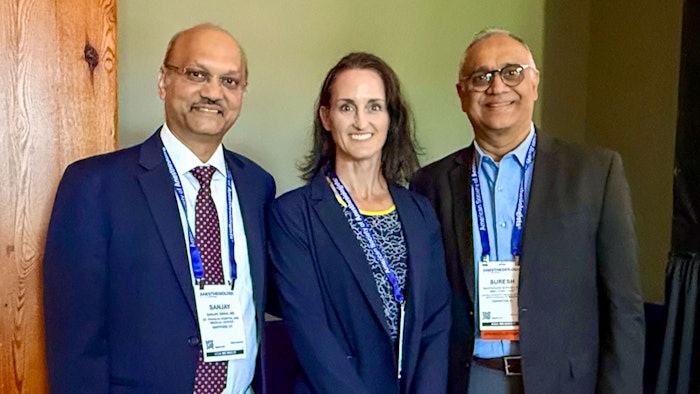Right knee, left knee, good knee, bad knee
Experts evaluate benefits and risks of anesthesia approaches, including emerging techniques, to knee surgery.

When it comes to knee surgery, time is of the essence. Patients with shorter hospital stays typically have better outcomes, and physicians are measured on patient length of stay results.
In the Saturday session “Fast-Tracking Knee Surgery in All Ages: An Evidence-Based Approach to Regional Anesthesia in These Patients,” speakers examined what, if anything, can be done to expedite postsurgical discharge and reviewed notable nerve block approaches that enhance recovery outcomes.
The world of anesthesia is evolving in large part to increased evidence on which blocks are more conducive to ambulating patients and new treatments that increase motor function. That’s according to session moderator Meg Rosenblatt, MD, FASA, an Anesthesiologist at Mount Sinai Hospital in New York City.
Children require knee surgery for two reasons, said Santhanam Suresh, MD, MBA, FASA. They may be born with or develop a physiologic condition — such as cerebral palsy, arthrogryposis, or epiphysiodesis — which often requires ongoing surgeries throughout childhood. Or they could incur an injury like an ACL tear or patellar dislocation while playing sports. Either way, they often present with acute pain.
What does differ between treating children versus adults is their skeletal immaturity, said Dr. Suresh, who is a Professor of Anesthesiology and Perioperative Medicine at Loyola University Medical Center in Chicago. Growth plates remain open for girls until they are 12 to 13 years old and in boys until they are 14 to 16 years old. This is an important consideration when forming an anesthesia strategy.
Dr. Suresh said a caudal nerve block should be used for knee surgery on infants or neonates, and it should be administered with ultrasound guidance. The approach for adolescents depends on location. If it is non-weight bearing, he recommends sciatic and femoral or adductor nerve block. If it is weight bearing, it should be anterior cutaneous canal nerve block or infiltration between popliteal artery and capsule of the knee (better known as iPACK).
Two birds, one stone
Session speaker Sanjay Sinha, MD, began by considering the totality of the surgical pain cycle. Traditionally, an anesthesiologist provides pain service during the onset of acute pain immediately following surgery. However, there lies an analgesic gap of subacute pain.
One must consider well in advance how to effectively manage pain during this translational phase and prevent chronic pain to enhance outcomes.
Dr. Sinha, who is an Anesthesiologist at St. Francis Hospital and Medical Center in Connecticut, said he believes the answer is neuromodulation. Although it cannot control subacute pain alone, he said it has proven to reduce pain scores when added to a single nerve block.
Unfortunately, it is inefficient and invasive to place a peripheral nerve stimulation (PNS) device leading up to surgery, as well as a nerve block before surgery. Dr. Sinha, who also cofounded Gate Science Inc., took this as a challenge to create an advanced technique that could deliver local anesthesia to block pain sensors at the molecular level and produce a signal to later block pain at the synaptic gate in the dorsal horn.
Independent studies of Dr. Sinha’s system found that following total knee replacement (TKR), patients returned to baseline mobility in two weeks and exceeded baseline mobility in six weeks, with zero instances of falls, motor weakness, or infection. In cases where TKR subacute pain could not be managed with analgesics, the use of PNS reduced pain by 93%.
Dr. Sinha concluded that the future of pain management is the triple threat of multimodal medications, regional anesthesia, and neuromodulation.
Coverage is key
The third presenter, Sylvia Wilson, MD, dove deep into retrospective study and clinical trial data of nerve blocks. Dr. Wilson, a Professor in the Department of Anesthesiology and Perioperative Medicine at Medical University of South Carolina, said there isn’t much to support improvement in length of stay because of the fixed psychological component. What can help, though, is to select an anesthesia approach that maximizes the complete nerve area.
A femoral nerve block, which primarily targets the saphenous nerve, is not sufficient, she said. Rather, targeting the anterior femoral cutaneous nerve provides coverage of the intermediate and medial femoral cutaneous nerves.
Evidence does support the use of iPACK in conjunction with adductor canal block (ACB), said Dr. Wilson, who reviewed a study that found iPACK alone (in comparison to ACB alone) can:
- Decrease opioid use at postop days one through three
- Decrease pain at postop days one through three
- Increase patient satisfaction at postop day one.
Dr. Wilson discussed other nerve block options, including genicular nerve blocks, periarticular injections, and local infiltration analgesia. Ultimately, she said anesthesiologists have an amazing armamentarium at their fingertips, but additional large-scale randomized controlled trials would be of great benefit to solidify and standardize recommended approaches.



